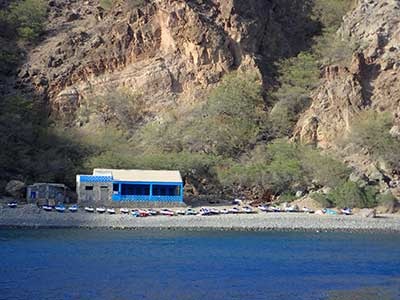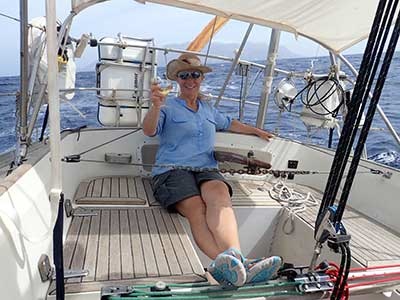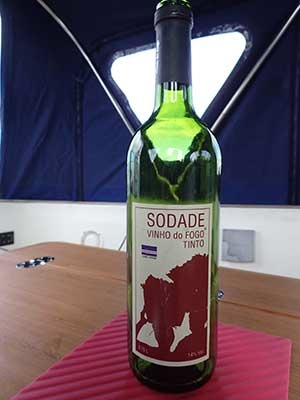Baia dos Ferreiros, Brava and onwards

Caramor - sailing around the world
Franco Ferrero / Kath Mcnulty
Tue 10 Mar 2015 13:54
After filling up with water at Mindelo Marina with the help of a yacht delivery crew heading for Cape Town we were ready to sail towards Brava. Our passage was fast, under genoa only, and we arrived just after twenty-four hours. We were surprised on entering the bay of Ferreiros how busy it was with a very large fleet of small fishing boats, some with outboards but many powered by oars alone. There are usually two men to a boat with an oar each, the one at the front rows backwards while the one in the back rows (surprisingly) forwards. Williwaws (strong gusts of wind) were coming off the cliffs, making it hard for those still out fishing to return to shore.
The pilot suggests anchoring in 15 metres, this was confirmed by Philippe whom we met in Graciosa and knows the island well. This is deep for anchoring and requires over 50 metres of chain. We went in slowly and made ready, a fishing boat with three hands on deck approached, they said "not there, you need to go deeper" and showed us to a better spot. Once safely secured to the sea bottom we worked out that the place we were going to anchor was rocky and the holding wouldn't have been as good.
The fishing fleet at Baia dos Ferreiros
Our helpers asked if we had any cigarettes. Franco and I have discussed whether to carry tobacco but we both have doubts as to the value of a present which says "this product could kill you" on the wrapping. We have been carrying four cans of beer since Galicia and offered these instead, they were pleased with the present.
Unlike the other places we have visited, a yacht in Ferreiros bay still has novelty value and many of the fishermen came over to say hello or to see whether they could trade with us. We had no Escudos left, not a problem in Brava where the economy relies mostly on barter but we had little to barter, dried chickpeas don't do well on the exchange rate.
One guy called José asked Franco if we wanted any fish, Franco explained that all we had left to barter was one can of beer, he didn't drink he told us, his young helper leapt up "I do" so Franco gave him the beer. José was talking "I'll work for you for a day, I'll get you fruit and veg, I'll do anything you want, all I want is one ..." One what? "A memory stick, he wants a memory stick" Franco shouted down to me. There is now a man in Brava with a 'Wood for Good' memory stick, on it plenty of room for storage and a promotional video about UK forestry, I wonder what he will make of that!
Brava is possibly not as poor as the landscape suggests, we have read that many from the island join the merchant navy, travel the world for a few years and return home with a good stash of cash. The only shop in Tantoum, the village above the bay sells grogue, the local rum, memory sticks are hard to come by.
We decided to stay one night only, we were ready for our crossing and our fresh food is limited. Brava will definitely be on the itinerary if we ever return to Cape Verde.
As we motored out the following morning to find the Trades, we swapped katabatic winds for a pod of acrobatic dolphins - a good omen.
Kath looking forward to a relaxed tropical ocean passage (as described in the brochure) ... it didn't last!
We passed Fogo in the haze. This volcano island rises to 2,829 metres and has recently been erupting from October 2014 until mid February. It has caused a real tragedy; the village in the crater has been completely buried in molten lava, all the farm land and vineyards are now under several metres of rock. Two houses were spared but who would want to live there surrounded by solid lava? The burgeoning wine industry has also been wiped out, we tried a bottle, it had a long way to go to compete with portuguese or spanish wines. The eruption is well documented on the internet. A programme of food aid has been organised for the displaced people, government posters have encouraged Cape-verdeans to donate one kilogram of food and volunteers have been picketing supermarkets asking shoppers to contribute.
Fogo wine (one of the last bottles to be produced)
We spent the first three hours pandering to the wind's every little whim: genoa out to the right, main up, one reef, gybe, genoa to the left, main down, gybe again. When the wind shifted direction by 180 degrees we threw up our arms in disgust and refused to play.
Eventually the wind settled down and we hoisted no.2 genoa to sail downwind with twin headsails poled out. Preparing everything takes a long time, not helped by a pitching boat. At last we returned to the cockpit, "fancy a cup of tea?" asked Franco.
DONG!
The older pole had come crashing to the deck. The pin that holds it to the mast had come apart, only one bit left. We took the sail down and Franco worked out a way to tie the pole onto the mast, not ideal but it would work. We lashed the pole in place and as we were about to hoist the sail we found the missing parts. We were thrilled. We screwed it back together again and hoisted the sail once more. A hard day's work and definitely time for a cup of tea.
The wind then dropped to a mere 6 knots. Poor Caramor who is so used to running has had to learn to crawl, and crawl one mile after the next over this big Atlantic Ocean she has been doing for the past three days. She is getting the hang of it and going a little bit faster now.
It's sunny and warm and the food is good. The motion gets annoying when it spills the egg custard but isn't bad enough to stop us sleeping.
We watch, amazed, as flying fish squadrons pass by in tight formation.
Kath
The Atlantic Ocean
P.S. Glass content is apple juice, Caramor is a dry vessel at sea.


